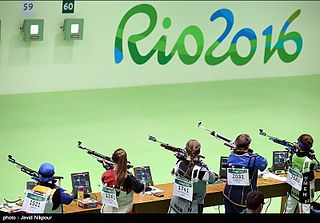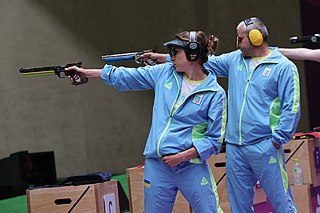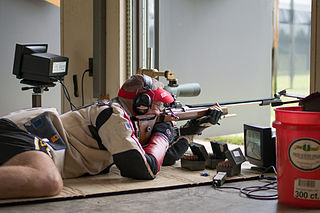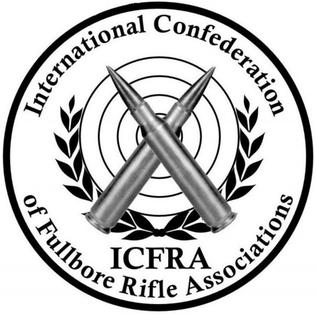
A shotgun is a long-barreled firearm designed to shoot a straight-walled cartridge known as a shotshell, which discharges numerous small spherical projectiles called shot, or a single solid projectile called a slug. Shotguns are most commonly used as smoothbore firearms, meaning that their gun barrels have no rifling on the inner wall, but rifled barrels for shooting sabot slugs are also available.

Shooting sports is a group of competitive and recreational sporting activities involving proficiency tests of accuracy, precision and speed in shooting — the art of using ranged weapons, mainly small arms and bows/crossbows.

An air gun or airgun is a gun that uses energy from compressed air or other gases that are mechanically pressurized and then released to propel and accelerate projectiles, similar to the principle of the primitive blowgun. This is in contrast to a firearm, which shoots projectiles using energy generated via exothermic combustion (deflagration) of chemical propellants, most often black powder or smokeless powder.

The International Shooting Sport Federation recognizes several shooting events, some of which have Olympic status. They are divided into four disciplines: rifle, pistol, shotgun and running target.

A shooting range, firing range, gun range or shooting ground is a specialized facility, venue, or field designed specifically for firearm usage qualifications, training, practice, or competitions. Some shooting ranges are operated by military or law enforcement agencies, though the majority of ranges are privately owned by civilians and sporting clubs and cater mostly to recreational shooters. Each facility is typically overseen by one or more supervisory personnel, known as a Range Officer (RO), or sometimes a range master in the United States. Supervisory personnel are responsible for ensuring that all safety rules and relevant laws are followed at all times.

Metallic silhouette shooting is a group of target shooting disciplines that involves shooting at steel targets representing game animals at varying distances, seeking to knock the metal target over. Metallic silhouette is shot with large bore rifles fired freehand without support out to 500 meters, and with large bore handguns from the prone position with only body support out to 200 meters. Competitions are also held with airguns and black-powder firearms. A related genre is shot with bow and arrow, the metal targets being replaced with cardboard or foam. The targets used are rams, turkeys, pigs, and chickens, which are cut to different scales and set at certain distances from the shooter depending on the specific discipline.

Benchrest shooting is a shooting sport discipline in which high-precision rifles are rested on a table or bench – rather than being carried in the shooter's hands – while shooting at paper or steel targets, hence the name "benchrest". Both the forearm and buttstock of such a rifle are usually fully supported by bean bags, a bipod/monopod (front/rear) combination, and/or a specially designed fixture device called shooting rest, so that the gun can remain stably pointing at the target without needing to be held by someone. When shooting, the shooter simply sits/stands comfortably behind the table/bench, operates the action and pulls the trigger, without needing to worry about carrying any weight of the gun. This is in contrast to other shooting disciplines, where the shooter has to bear at least part of the gun's weight while holding it steady to aim, even when using support devices such as bipods, tripods or shooting sticks.

10 metre air rifle is an International Shooting Sports Federation (ISSF) shooting event, shot at a bullseye target over a distance of 10 meters using a 4.5 mm (0.177 in) calibre air rifle with a maximum weight of 5.5 kg (12.13 lb). It is one of the ISSF-governed shooting sports included in the Summer Olympics since the 1984 Los Angeles Games.

The 10 meter air pistol is an Olympic shooting event governed by the International Shooting Sport Federation (ISSF). It is similar to 10 meter air rifle in that it is shot with 4.5 mm caliber air guns at a distance of 10 metres (11 yards), and that the match consists of a qualification round of 60 competition shots within 75 minutes. If an Electronic Scoring System (EST) is not available, 15 minutes are added to the time limit. Competitors are allowed to shoot an unlimited number of shots during the 15 minutes preparation and sighting time. Along with the 50 meter pistol, it is considered a precision shooting event. Thus, numerous shooters compete in both events.

The International Shooting Sport Federation (ISSF) is the governing body of the Olympic shooting events. It also regulates several non-Olympic shooting sport events. The Federation's activities include regulation of the sport, managing Olympic qualification events and quota places, as well as organization of international competitions such as the ISSF World Cup series and ISSF World Championships.

Shooting ranges in Switzerland are characterised by the widespread provision of targets at 300 metres (330 yd) for service rifle training and qualification, along with a schützenhaus which serves as a community hub for local schützenverein, often including bar and cafe for social events. This results from long-standing connections with Switzerland's militia system, which has led to strong civilian shooting traditions and liberal gun laws.

Paralympic shooting, also known as shooting Para sport, is an adaptation of shooting sports for competitors with disabilities. Shooting is a test of accuracy and control, in which competitors use pistols or rifles to fire a series of shots at a stationary target. Each shot is worth a maximum score of 10.9 points. Athletes use .22 caliber rifles, pistols and .177 caliber air guns. Paralympic shooting first appeared in the Summer Paralympics at the 1976 Toronto Games.

50 meter rifle three positions is an International Shooting Sport Federation event, a miniature version of 300 meter rifle three positions. It consists of the kneeling, prone, and standing positions, fired in that order, traditionally with 3×40 shots for men and 3×20 shots for women. In January 2018, the number of shots was equalised between genders with the Women's 3x20 being abolished in favour of a 3x40 match identical to the men's event. The caliber is .22 Long Rifle (5.6 mm).
The Walther LGR air rifle was developed by the German arms manufacturer Carl Walther GmbH Sportwaffen as a high end match rifle for 10 metre air rifle competition shooting. The LGR was the first match air rifle that employed the then futuristic single-stroke pneumatic method as power source. This use of pre compressed air introduced the advantages of recoilless and vibration free shooting in combination with a well-made air rifle into the sport. It took other manufacturers a decade before they also introduced single-stroke pneumatic match air rifles.

The Philippine National Shooting Association (PNSA) is the National Sports Association (NSA) governing shooting sports in the Philippines, covering both Olympic discipline shooting sports and non-Olympic shooting events like the bench rest or practical pistol. PNSA is the Philippine shooting sport NSA recognized by and a regular member of the Philippine Olympic Committee (POC), funded by the Philippine Sports Commission (PSC).

Match crossbow is a target shooting sport using crossbows. Unlike field crossbow, match crossbow is quite similar to the Olympic rifle.

Shooting targets are objects in various forms and shapes that are used for pistol, rifle, shotgun and other shooting sports, as well as in darts, target archery, crossbow shooting and other non-firearm related sports. The center is often called the bullseye. Targets can for instance be made of paper, "self healing" rubber or steel. There are also electronic targets that electronically can provide the shooter with precise feedback of the shot placement.

Bullseye shooting is a category of shooting sport disciplines where the objective is to score points with carefully placed precision fire by hitting a target as close to its center as possible. The name refers to the target center's nickname, the "bull's eye". In Scandinavia, this type of shooting competition is referred to as Range-Shooting, as it usually takes place at dedicated shooting range.

A bullet trap is a device to stop and collect projectiles fired at a shooting range to prevent overpenetrations and stray shots. Bullet traps typically use friction, impact or gradual deceleration to stop bullets. They can function as a backstop by themselves or be part of a larger backstop, e.g. placed in front of a thick rubber wall or a bay of sand.

The International Confederation of Fullbore Rifle Associations (ICFRA) is the international association for the fullbore rifle shooting sports of Target Rifle ('TR') (in the US 'Palma' Rifle) and F-Class, which are long range competitions shot at distances between 300 and 900 meters or 300 to 1,000 yards depending on the range. F-Class shooters often shoot concurrently with the world's long-range TR shooters and use the same targets, except that the F-Class target has an extra ring half the diameter of the smallest in use for TR. ICFRA manages the programme of World Championships and other major matches for Fullbore Rifle and seeks to standardize the competition rules for TR and F-Class around the world.























